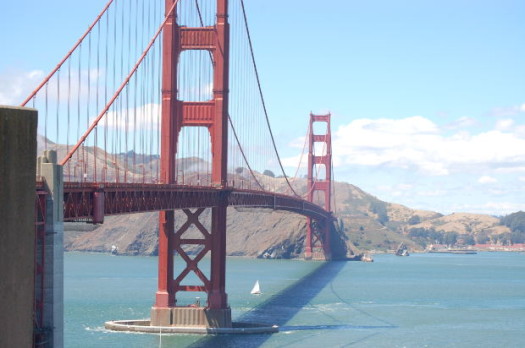"not blue" is not a color
Construction on the bridge that spanned the Golden Gate Strait, the entrance from the Pacific Ocean into the San Francisco Bay, finished in 1937. It was the largest suspension bridge in the world at the time, and it was beautiful. The San Francisco Chronicle called it “a 35 million dollar steel harp.”
At the end of construction, the only decision architects and engineers had left to make was what color to paint the bridge. Everyone had a different opinion about what color the bridge should be, but the one thing they all agreed on was this: the bridge could not be blue.
A blue bridge would too easily blend in with the sky above and the water below, which could be disastrous for planes and large ships. So the initial answer to the question of what color the bridge should be was “Not Blue.”
Over recent years, there has been a robust discussion amongst progressive American Christians about the role of church attendance in their faith practices. People have weighed in about whether they go to church or not, and why they’ve made that decision. (See Rachel Held Evans' reasons for leaving and returning to the church, Frank Schaeffer's HuffPo piece on problems and proposed solutions for mainline evangelical churches, Christine Organ's Relevant magazine piece on why she still goes to church, and T.M. Luhrmann's NYT piece on why church is good for you, just to name a few…)
It’s become a kind of litmus test -- are you the kind of Christian who believes in church or not? And it’s become the most common side conversation amongst many of my friends -- some of whom are pastors, some of whom left the church long ago.
Donald Miller’s recent writing about his experience of church and his reasons for not going (at least not often) set off a firestorm of responses. The initial post was about how church was difficult for some people depending on their learning style, but it touched a very sensitive nerve in people, who had vociferous responses (Note: if you read the original post, please read the follow-up one as well to get his full meaning and context. And if you’re going to respond in his articles’ comment sections, please for the love of everything, be kind.)
As I’ve read various articles and responses on the topic of church, it has started to remind me of the Golden Gate Bridge discussion. For those who love Jesus and care about his followers, this question will always be before us: What’s the best, healthiest, most biblical way to have community with other people who follow Jesus? What should church look like, and what role does it play in our spiritual formation and fellowship?
I don’t know anyone who would say that the church, as it stands now, is as it was meant to be. Anything comprised of and directed by humans is bound to have flaws.
But thousands of years after Jesus left the earth, after Paul told people not to stop gathering together, the church still exists. It is going strong in many places, and it is important for many reasons. The church, defined as a physical place where Christ followers gather weekly, is a tangible presence in the community. It’s a safe place where people who are lost know they can go. And it’s a place where many of us go back week after week to learn and worship and converse and be reminded that we’re not alone in our faith.
The conversation of what church can and should look like goes on, and (with thoughtfulness and civility), it should. Because this question will never go away, and it’s important for all of us to wrestle our answer to the ground.
At this point in the conversation, from my perspective, we’re like the engineers and architects who have all answered the question of “What color should the bridge be?” with a resounding, “Not Blue!” We’ve answered the question, “What should church look like?” with the answer, “Not like this!” Because church isn’t perfect, and there is a lot of opportunity for innovation and imagination and change.
But “Not Blue!” is not a color. Declaring that the church should be “Not like this!” and walking away is not the final answer to the question of church; it’s just the beginning of an incredibly important conversation.
After many conversations about what color the Golden Gate Bridge should be, in the end, one of the chief architects decided the bridge should be painted a vibrant orange -- because orange is the opposite of blue on the color wheel, so it was an unmistakable contrast to the blue water and sky. And orange was also the color of the terra cotta San Francisco hills, so the bridge’s edges also blended perfectly with the surrounding landscape.
I hope as this conversation goes on, we find a vision for the church that is both a vivid contrast to a fallen world, and at the same time is beautifully similar to the early church from which it arose.

